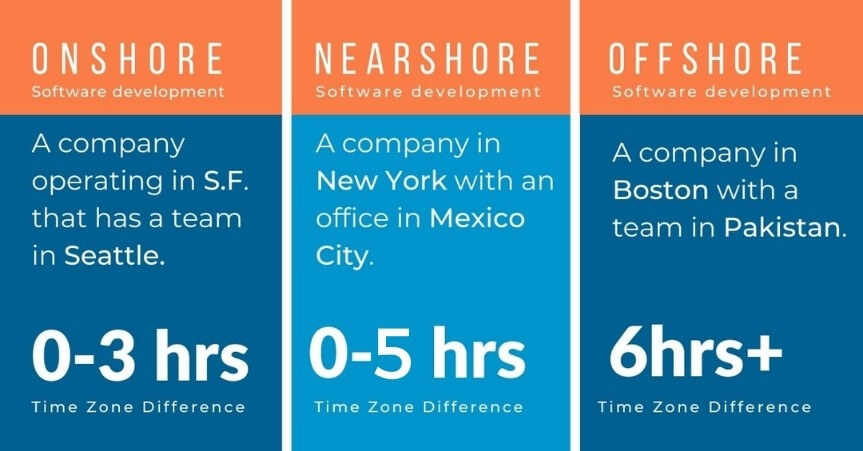
An ever-increasing number of businesses are turning to outsourcing to free themselves from hiring, training, and maintaining in-house employees.
This enables them to save time and money while tapping into a virtually endless stream of experienced IT talent.
We've defined what it means to outsource software development onshore, offshore, and nearshore, as well as provide tips on how to decide which choice makes the most sense for your project or business.
Article originally published at bluecoding.com - "Nearshore, Onshore & Offshore: what's the difference?"
What's the difference between onshore, nearshore, and offshore software development?

When it comes to outsourcing software development, there are three location-based variations: onshore, nearshore, and offshore.
Each option inherently different with its own unique advantages.
Let’s start by defining each term in detail, and then we'll break down the benefits of each option.
Onshore software development definition

Onshore software development is the process of building or maintaining software using a team located in the same country as you. That could mean freelancers, third-party software development companies, or even in-house employees. Although the term is usually associated with outsourcing.
An example of onshore software development: would be a company operating in the Bay Area that hires freelancers or independent contractors in a nearby city like Seattle.
While hiring outside the bay area allows them to save a little bit of money on salaries they still have a relatively high level of oversight and control.
Offshore software development definition
Offshore development refers to working with developers or an agency located outside of your country, usually with a significant time zone difference of six hours or more. In some cases, like with China or the Philippines, the time difference with North America can be as much as 12 hours.
An example of offshore software development: would be a software company in New York that hires a team in Pakistan to help with their software deployments. At times the time zone differences can be an advantage like when you want a team to help with late-night deployments or need 24hr coverage.
With offshoring, we recommend working with an agency or outsourcing partner over an individual freelance developer. With offshore development, you need to pay special attention to communication, and working with a firm tends to be more reliable.
Nearshore software development definition

Nearshore software development refers to hiring foreign talent in countries with timezone parity or at least significant time zone overlap.
It’s hard to say exactly when nearshore becomes offshore. We've even seen companies in Europe and Africa referred to as "nearshore" in the past, despite having a six-hour plus time difference with North America.
We feel that to be considered nearshore the time difference should be no greater than 3-5 hours and in many cases, there will be no timezone difference at all.
An example of nearshore development: would be a startup or large corporation that opens a software development center in a country like Mexico to gain a permanent foothold securing affordable IT talent.
Popular nearshore locations for North American companies to outsource software development include Mexico, Brazil, Colombia, Costa Rica, and Argentina.
Interested in working with a dedicated nearshore software development team? Learn more about our managed software development services here.
Onshore software development benefits
Onshore development offers two significant advantages: cultural familiarity and ease of communication. Those are likely the two main components driving the demand for onshore talent. Although this difference may grow less noticeable over time as the number of foreign tech workers in North America grows.
Onshore development also means closer geographic proximity than the other two options. Meaning if you like to meet up with your remote contributors regularly and in-person this could be a cost advantage.
What's the drawback?
One of the main drawbacks is, as you might have guessed, the price tag. Hourly rates for freelancers and inexperienced developers based in North America can rival those of an experienced senior developer based nearshore or offshore.
Offshore software development benefits

Offshore software development can be a good option for bootstrapped startups and other small businesses because of its affordable rates. You’re also looking at the largest pool of IT talent in the world, including IT outsourcing powerhouses like China, Pakistan, and India.
What’s the downside? Well, it depends on the country and whether you’re dealing with an agency or a freelancer.
For example: if you're outsourcing to a popular outsourcing destination like the Philippines, contacting freelancers or small agencies during monsoon season (June-October) can be especially tricky.
Communication difficulties aren’t just limited to countries with tropical climates either – serious communication challenges and cultural barriers can lead to a project going off the rails or cause you to miss deadlines.
Working with a team that can’t communicate effectively is not an option, especially when they’re located halfway around the world. Generally speaking the farther the location is from your main operation, the larger the logistical challenge will be to get your team set up and running.
Nearshore software development benefits
With nearshore development, you can maintain close control of your projects. Your partner is nearby allowing you to communicate clearly and collaborate in real-time.
You can say that with nearshore development you get the best of both worlds. You see significant cost benefits without sacrificing efficiency or compromising on quality.
Interested in working with skilled nearshore development talent? Learn about our nearshore staff augmentation services.
What are the downsides?
You’ll need to pay special attention to English proficiency, something that’s probably usually not even on your radar, and with the international demand for skilled developers with fluent English on the rise, don’t expect to be paying the local going rate either.
In summary: nearshore offers better communication and control than offshore, while still providing considerable cost benefits as well as requiring less maintenance. The quality of work is second only to onshore development but at a considerably lower cost.
You can learn more about the advantages of nearshore software development here.
Conclusion
- Outsourcing allows you to outperform larger competitors by accessing untapped talent markets, lowering your operating costs, and allowing you to complete projects faster.
- Finding the right outsourcing partner is one of the most important aspects of making onshore, nearshore, or offshore development work.
- Increasing globalization and wider adoption of remote work culture, have lowered the barrier for outsourcing.
Haven't decided which option makes the most sense for your business? Book a free outsourcing strategy call, to find out if nearshore development is right for you.



























